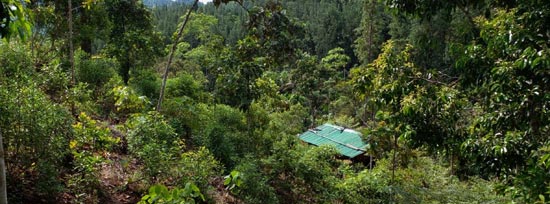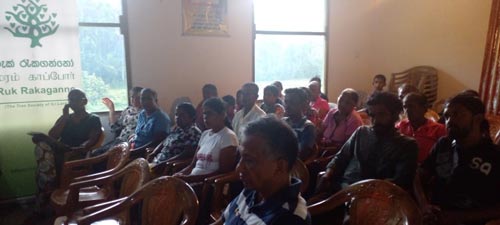Green cover again for this corner of Sinharaja

Progress by December: The greening of Suduwelipotha
Veddagala’s hills may no longer harbour the Veddahs, but they stand in the eternal shadow of the Sinharaja adaviya. This is where Ruk Rakaganno, the Tree Society of Sri Lanka, is working to bring a new lease of life to the denizens of the forest and to compensate for human greed that has dwindled our island’s forest cover to just 34 percent (as of 2020).
Ruk Rakaganno was begun by a group of like-minded nature loving personalities such as veteran actress Irangani Serasinghe (‘Chandi’ Meedeniya to the inner set), her friend and erstwhile colleague at the Times of Ceylon, the renowned photographer Nihal Fernando, soil scientist Dr Chris Panabokke, photographer Pat Decker et al. It is today a dynamic organism that tends to what our ancestors called the ruk deviyo - green ‘deities’ without whom we lose the precarious balance that keeps our planet alive.
We rambled through Sabaragamuwa’s prehistoric rainforest – lush, wet, and loamy with crystal clear streams gushing but it was sad to see the diyapara and kekille (bracken)- spilling all over hill and roadside in a thick blanket.
The first stop was at Suduwelipotha to see the ecological reforestation project. This 24-hectare land has been leased to Ruk Rakaganno by the Forest Department to reforest for four years. Though originally part of the pristine forest, it had been at one point cleared and pine (Pinus caribaea) trees had been grown which naturally meant it became barren. Today, just two years after Ruk Raks took it on, the difference is evident.
We tramped through mists and drizzle to a hut where Rohan Pandiperuma, Coordinating Manager for Ruk Rakaganno on the project, had a spread of hot lavariya and steaming coffee in coconut shells. Cooing around us were emerald doves and Layard’s parakeets- occasionally making so bold as to fly through the hut.
The whole project is in memory of a gentle green crusader, Kamini Meedeniya-Vitarana who spearheaded the Ruk Raks for quite a while.

Next step: Villagers being briefed about the bee-keeping project.
With funding entirely from John Keells Foundation and technical advice from John Keells Hotels (Vimukthi Weeratunge was technical advisor from Cinnamon Hotel Management), Ruk Rakaganno became foster parents to this ravaged land and set about planning a nursery that would be as well forested as any other part of the Sinharaja in just 25 years.
It was to Prof. Siril Wijesundera of the National Institute of Fundamental Studies, that they turned for the nursery plan. A former Director of the Botanical Gardens, Peradeniya, he first obtained a list of the plants that Dushy Perera, chairman of Ruk Rakaganno, had collected, and separated them according to shape, height and character to simulate the model of a rainforest.
This was done so that a natural rainforest would be raised phoenix-like, with the interplay of canopies, sub canopies and other layers down to the undergrowth where much life from nightjar to a wealth of insects thrived.
Before planting however they had to remove the invasive plants Kekille and Diyapara. They were used for compost.
Altogether 71 species of trees, amounting to 15,300 individual plants, are now distributed between 17 blocks.
Sometime later John Keells bequeathed a further donation of Rupees one million to have caves and ponds to attract bats, frogs and fish (and hopefully more ‘charismatic’ fauna) to the land as the first steps towards re-wilding.
Also added to the forest were butterfly-attracting trees like balu-nakuta, weraniya and pinne.
But the Ruk Raks had something sweeter to unpack on this most recent visit on July 25: a bee-keeping project, covering the Veddagala area monitored by Dr Wasantha Punchihewa, a charismatic scientist who rejoices in being called an entomologist though he is much more.
Gathered in the Suduwelipotha community hall despite a torrential monsoonal downpour outside, were some 50 villagers, there because they were curious as to what the ‘Colombo gentlemen’ had to promote.
Their eyes first apprehensive, their sombre faces cleared as Dr Punchihewa, with his easy manner explained that the rearing of bees for the ‘manna of the jungle’ could be very lucrative.
There was a count of raised hands at the end as to how many were eager and many readily expressed enthusiasm to sign up.
While the boxes and required training are to be provided by Ruk Rakaganno and Dr Punchihewa, the biologist however set an initial task for the villagers. They were asked to procure a broken clay pot and attract wild bees, plentiful in the forests nearby. Over subsequent visits over the next so many months he will distribute kits and train them in the art – something ‘not even as difficult as learning to ride a bike’ he added encouragingly.
This beekeeping project is entirely funded by the Deutsche Bank AG Colombo.
Meanwhile, Ruk Rakaganno hope to get an extension of their four-year lease of Suduwelipotha from the Forest Department so they could help the upkeep of their thriving territory till it is on a sure footing to rise with the rest of the primordial forest.
Searching for an ideal partner? Find your soul mate on Hitad.lk, Sri Lanka's favourite marriage proposals page. With Hitad.lk matrimonial advertisements you have access to thousands of ads from potential suitors who are looking for someone just like you.


